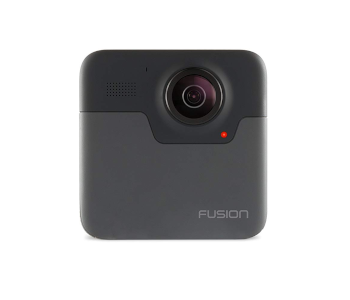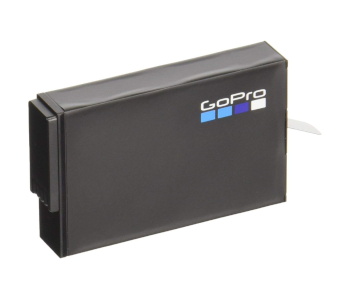A Review of the GoPro Fusion – the 360 Camera from GoPro
Although the market for action cameras have become as competitive as ever with companies like DJI, Sony, Olympus, and Yi, the position of GoPro at the top can hardly be argued. Encouraged by this success, GoPro released their first 360 camera last year: the GoPro Fusion.
How does GoPro fare in developing a completely new product? Can the GoPro Fusion compete with more established 360 cameras like the Ricoh Theta V or the Xiaomi Mijia? Is the GoPro Fusion still worth the purchase more than a year after it was launched?
Overview

The Fusion was a hotly anticipated product from GoPro because of their excellent track record of developing compact and weather-proof action cameras. There’s also the fact that GoPro has already dabbled in 360 camera technology – the GoPro Odyssey and the GoPro Omni – although those were huge multi-camera rigs.
The Fusion was the first portable, all-in-one camera produced by GoPro. It was initially slated for release in 2018 but ended up getting released a few months earlier in November 2017. The launch price for the GoPro Fusion was an intimidating $699.
Build and design
Compared to GoPro action cameras and other 360 cameras, the Fusion is larger and heavier. With a weight of 226 grams and measuring 73 x 75 x 23 millimeters, the Fusion isn’t exactly a huge bother to carry around. The bottom portion of the camera is coated with thick rubber, which not only contributes to weatherproofing but also provides a convenient and secure grip. If anything, the extra heft helps make the GoPro Fusion feel like a more premium product.
True to the GoPro brand, the Fusion is shockproof and waterproof up to 16 feet. This characteristic alone sets the GoPro Fusion apart from about a dozen other popular 360 cameras. This isn’t just a 360 camera for capturing photos and videos indoors or while walking down the street – it’s also an action camera that can handle your most rugged adventures.
There are a couple of other design elements that the Fusion inherited from the Hero line of action cameras. GoPro Hero owners will feel right at home with the simple two-button interface for scrolling through the various modes and settings. It also has the characteristic front-facing LCD information screen. The touchscreen panel of the newer Hero cameras didn’t make it to the Fusion, though, which may be an indicator of how early on the development of this camera had started.
It’s hardly a surprise, but the Fusion also comes with the standard three-prong GoPro mount. This is great news if you already own a GoPro Hero, as it means that the Fusion is instantly compatible with all your accessories. If you’re a newbie to GoPro products, then you’ll be glad to know that the Fusion ships with two adhesive mounts and a telescoping “selfie stick.”
Battery and storage

The primary reason for why the GoPro Fusion is so big and heavy is that it comes with a super-sized 2620-mAh Li-ion battery. This battery is more than enough to fill 32 GB SD cards in one go.
Speaking of SD cards, one of the more peculiar aspects of the Fusion is that it comes with two SD card slots – one for each lens. This isn’t as big of an issue as we had anticipated, as the camera seamlessly combines the files from the two SD cards while the data is transferred either via WiFi or a USB connection. It’s also possible to transfer to stitch the files together using the Fusion desktop software, should you opt to transfer them to your workstation using a card reader.
In another nice touch, the Fusion ships with two 32GB SanDisk microSD cards. Between the SD cards and mounts, the GoPro Fusion is virtually ready to use out of the box.
The SD card slots, as well as the battery and the USB-C port for charging, are hidden inside two waterproof sliding doors. If you intend to use the Fusion to capture long stretches of video, you have the option of powering it through the USB-C port. Just take note that GoPro recommends that you remove the battery should you decide to use the camera in this setup.
Image and video quality
Each of the two cameras of the GoPro Fusion has a sensor size of 1/2.3” and a fixed aperture of f/2.8. It has three video modes: 5.8K at 24 fps, 5.2K at 30 fps, and 3K at 60 fps. Stills are captured at 18 MP.
The video and image quality of the Fusion doesn’t disappoint, although you will need to keep in mind that a flat 5.2K video will not look the same as a 360-degree version because the pixels are distributed over a larger area. The level of detail is still impeccable, though, and we can’t find much to complain about in terms of color accuracy and quality.
Bright areas do tend to come out overexposed when shooting in auto mode, but more savvy users always have the option of adjusting the ISO and exposure settings in Protune mode.
One of the highlighted features of the Fusion is the OverCapture mode. When OverCapture is activated, the Fusion records a continuous 360-degree video, capturing everything that happens around it. Essentially, OverCapture allows you to record a video just once but allows you to reframe and move it around in an unlimited number of ways. This could be a revolutionary feature in the right hands, as it means that you don’t need to capture the “perfect” shot the first time around.
Stitching
A 360 camera can have excellent hardware, but poor stitching can still prove to be its downfall. We’re glad to report that this is not the case for the GoPro Fusion. In most cases, the Fusion can stitch images and videos without any noticeable artifacts.
Users may run into problems when the subject is either too close to the camera or is located at the stitch line between the two lenses. This is a pretty common limitation of 360 cameras, and one that GoPro hasn’t quite found a solution to yet. In this case, getting the best results is just a matter of reframing your shot.
The output quality of the stitching process does seem to differ based on whether you do it using the mobile app or the desktop-based Fusion Studio software. Fusion Studio tends to do a much cleaner job, while the mobile GoPro app produces images with a visible stitch line. Again, a good amount of planning your shots can make up for the lack of refinement of the mobile app, so it’s a good thing that the GoPro app provides a live feed from the camera.
Video and image stabilization

The GoPro Fusion comes with 6-axis gyro-aided software stabilization that is applied during the stitching process. This is an important feature for any 360 camera, but more so for the Fusion, which is being marketed with an action camera angle.
The performance of the Fusion’s stabilization feature is still unmistakably software-aided, meaning that it still does not match the results of true mechanical stabilization. Still, it does a great job of smoothing the vibrations of videos that have been recorded while running or biking.
Audio
The GoPro Fusion is designed to capture 360 spatial audio using a total of four microphones. Spatial sound, or ambisonic audio, has become a standard feature of 360 cameras that allow the audio to match the perspective of the video during playback, which creates a much more immersive experience. The Fusion performs quite well in terms of how it achieves this effect.
However, there is an inherent limitation to the audio quality that any internal microphone can attain. The four-microphone system does have an advanced wind noise reduction feature, but even this will fail in extremely windy and noisy environments. The four-microphone system is also incompatible with any type of external microphone. This is bad news for vloggers who want to record themselves talking over their videos.
If you want to record any type of spoken audio, then your best recourse would be to record it separately using some sort of lavalier microphone attached to a smartphone. You will then need to sync your recorded audio with the vide from the Fusion. This isn’t exactly an easy workaround.
User experience
Without the advantage of a touchscreen panel, setting up the GoPro Fusion using just the two control buttons can be quite time-consuming. There’s also the fact that the Fusion does not have a timer function, leaving you no choice but to control it using the companion mobile app if you want to capture a shot that does not include you in the frame.
Unfortunately, the GoPro mobile app leaves so much to be desired. Our list of problems with the app is long: the pairing process is unnecessarily complicated, doing anything with the app can be frustratingly slow, and it gets disconnected from the camera as soon as you step a few feet away.
When the app works, it’s a pretty handy tool. It provides an intuitive interface for adjusting the exposure and ISO settings and shows you a low-resolution live feed from the Fusion. You can use the mobile app to edit and stitch the files from the Fusion, but this can be a painfully slow process made worse by the fact that you’re editing on a very small screen.
Without any timer, your best option to capture anything on the Fusion that does not include you in the frame is to use the mobile app as an external shutter. This works well most of the time as long as you can keep your phone paired to the camera. There is another option – voice control.
The voice control feature of the Fusion makes it pretty unique as far as 360 cameras go. This is another feature that emphasizes the dual nature of the Fusion as both a 360 camera and an action camera. The voice commands are simple. The most important ones would probably be “GoPro, start recording” or “GoPro, take a photo.” The voice commands will certainly come in handy if you have the Fusion mounted on your bike handlebars or on the nose of your surfboard.
Post-processing

Professional photographers would be glad to know that the Fusion offers the option to capture in RAW mode when Protune mode is activated. This opens up a lot of color grading and correction opportunities during post-processing.
Something you’ll need to know about post-processing anything from the Fusion is that the files can get absurdly huge. If you do have the patience to spend several minutes transferring the files from the Fusion into your computer, then you’ll be glad to know that the Fusion Studio desktop software is incredibly easy to use. The software allows you to do a lot of edits to your videos – trim them, adjust color and exposure, among others – before you decide to render them.
Where the desktop software falls short is in how limited its options are for editing videos taken using the OverCapture feature. Since OverCapture takes a full 360-degree video, we imagined that GoPro will allow you to highly dynamic content with smooth zooms and pans. This was not the case. Fusion Studio only allows you to pick an angle for the video, which remains fixed for the whole duration.
Fortunately, it’s still possible to make those visions into reality. It’s going to be a bit more complicated, though, as you’ll need to use a professional video editing software like Adobe Premiere Pro or After Effects. GoPro provides plugins for both software platforms so they can support the native Fusion file formats. We’re glad that the option is there, but it would have been so much better if everything can be done using GoPro’s very own editing software.
When you’re satisfied with your edits, it’s time to render. If rendering a normal video takes a few hours, rendering a 360 video is going to take so much longer. Fusion Studio offers three rendering codecs: H.264, CineForm, and ProRes.
Post-launch support

GoPro continued to release firmware and software updates for the Fusion well into 2019, which is a sign that they may be more invested in this 360 camera business than we originally thought. A 2018 update introduced two new stabilization modes: full stabilization, which locks the Fusion to a single direction, and anti-shake, which smooths the motion of the camera and removes jitter.
The 2.0 version of the Fusion firmware introduced support for 5.2K resolution at 24 fps and added RAW support for night lapse and time-lapse modes. At the same time, Fusion Studio was also updated with improved stabilization, stitching, and image processing modes.
Price
Almost two years after it was launched, the GoPro Fusion can now be purchased at heavily discounted prices of as low as $300. This makes the Fusion slightly cheaper than other popular 360 cameras like the Ricoh Theta V or the Insta360 ONE X. Of course, there are still a couple of cheaper alternatives – like the YI 360, Xiaomi Mijia, and the Samsung Gear 360, to name a few.
Is the GoPro Fusion worth it?
Is it still worth it to get a GoPro Fusion in 2019? It’s been two years since the Fusion was launched, which means it’s already a little behind the curve in terms of technology. However, there are a couple of advantages to getting a GoPro Fusion now: it’s in much better shape now than it was first launched, and it’s so much cheaper.
In terms of output quality, the GoPro Fusion isn’t perfect. Both the Insta360 ONE X and the Ricoh Theta V arguably perform better in this department with better exposure and more options for how you can shoot or edit your videos. If you’re looking for something truly premium, then the Ricoh Theta Z1 boasts of two 1-inch CMOS sensors, which shoots up to 23 MP stills. The upgrade to 5.7K videos has been a much-needed improvement for the GoPro Fusion, as the Yi 360 is also capable of such a feat at about half the price.
The Fusion has also received a lot of criticism for how unpolished its workflow feels. Aside from the connectivity problems that have plagued its companion mobile app, getting anything done in the Fusion Studio desktop editing software takes way too long. However, the post-launch support for the Fusion has been encouraging. Hopefully, this is a sign that GoPro remains invested in the 360 camera market.
What the GoPro Fusion offers, which other 360 cameras do not, is its shockproof and waterproof build. So far, there is no other 360 camera as rugged as the Fusion. This is the unique value of the Fusion – and one we recognize may not be as important to some people.
If you’re looking for a 360 camera for shooting footage indoors to produce real estate advertising or for basic vlogging, then you can probably look for a cheaper 360 camera that is easier to use than the Fusion. However, if you’re planning on bringing a 360 camera to your biking, surfing, or skydiving adventure, then the Fusion is absolutely your best option.

